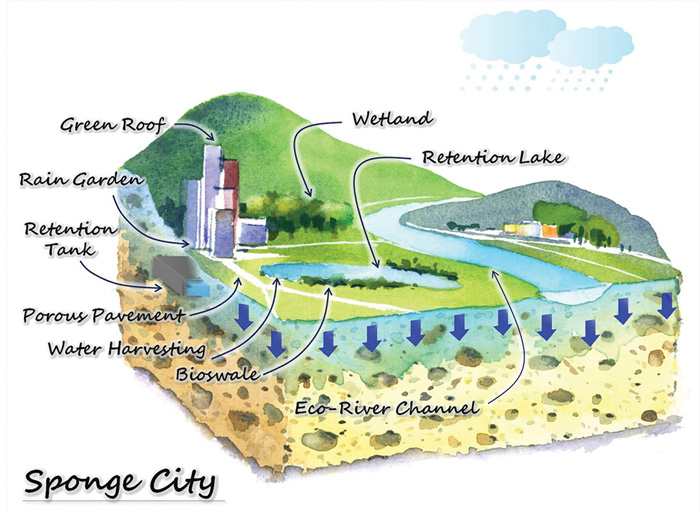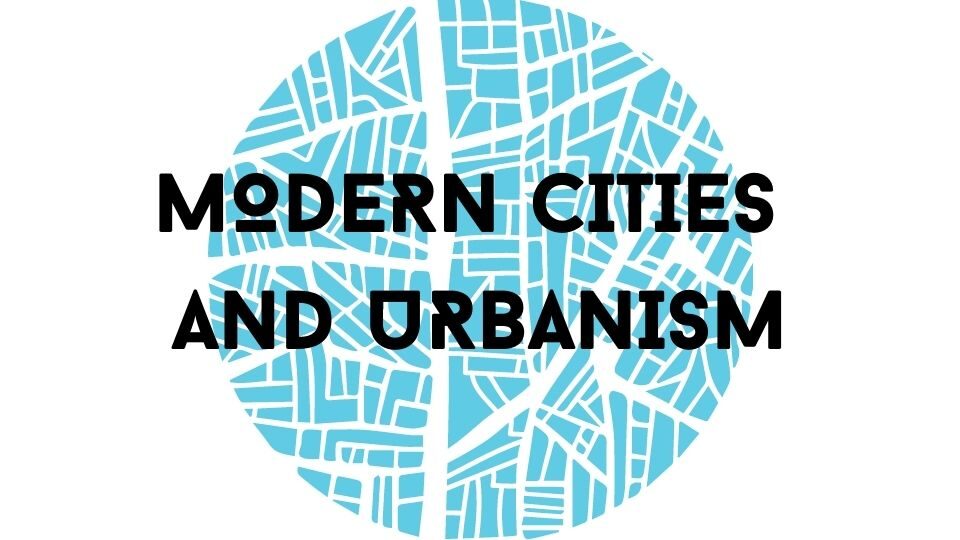Questions
How has Xi’an been affected by natural hazards or epidemic disease?
What measures were taken to eliminate these problems or mitigate their effects, when?
What side effects did those measures have?
Sponge City Xi’an
As an ancient capital, Xi’an has a long and unique history interacting with the two most commonly occurring natural disasters in China—droughts and floods. Situated on the southern edge of China’s loess plateau, the city is no stranger to arid summer days or water overflowing from nearby rivers (Wang 2010). Though one of the most fertile types of soil for agriculture, loess is porous and friable, and such properties explain the muddiness of the Yellow River in China. As increasing and unrestrained human activities over the past 1500 years have led to gradual but unchecked deforestation in areas North of Xi’an, extreme disasters have become more frequent (Wang 2010). Rapid loss of vegetation in the loess plateau also led to the formation and expansion of desserts, and for Xi’an, the expansion of the Mu Us Desert (毛乌素沙漠) has led to increasing occurrence of dust storms that plague many cities in Northern China during Spring (Ai 2004, 99-104).
Changing geography had lasting impacts on Xi’an’s climate. As precipitation decreased and arid days became more frequent, drought and dust storms increased in severity and frequency (Ai 2004, 100-101). As famine often accompanied extended periods of drought, scholars have theorized the drastic changes in the natural environment as key factors explaining why Xi’an failed to regain its economic and political status from the fall of the Tang Dynasty in the 10th century to the mid-20th century (Wang 2010).
After the founding of the People’s Republic of China, Xi’an became a major urban industrial base for the new country, and the city quickly developed and expanded. Natural disasters, however, persisted and at times caused great disruption to the lives of thousands of urban residents (Lu and Du 2008, 7-10). Since the 1950s, precipitation has gradually decreased in Xi’an while urbanization and industrialization created greater demand for water. Droughts during the 1990s posed especially serious challenges to the Xi’an government (Lu and Du 2008, 8). Although urbanization intensifies the effects of droughts by creating more demands for food and water, economic development has also made Xi’an more resilient to harsh weather conditions. Scholars have thus characterized Xi’an as one of the most sensitive yet resilient cities vis-à-vis drought in Shaanxi province (Yu, Yang, and Shi 2012, 585-586).
At the same time, annual dust storms continue to plague Xi’an in the Spring, covering the city in an orange haze. Unfortunately, much like drought, city planners have little to offer on how to mitigate these risks other than proposing better usage of underground water and constructing more green spaces within the city (Yu, Yang, and Shi 2012, 584; Lu and Du 8). As similar issues threaten the health and safety of Beijing, the central government launched the “Great Green Wall (三北防护林)” project in 1978 to plant windbreaking forest stripes to stabilize sand dunes and combat desertification. Although scholars still debate the long-term effects of China’s grand initiative, the 2021 massive dust storm raises doubt on the effectiveness of these shelter forests (Tan and Li 2015, 42-47; Johansen 2016, 324-325; Jiang 2016; 513-536). Nevertheless, for Xi’an, dust storms have largely disappeared since the 2000s.
Ironically, as Xi’an becomes more resilient to drought and dust storms, the opposite challenge is becoming increasingly acute. Although average annual precipitation has followed a downward trend between 1950 and 1990, the frequency of extreme precipitation events has increased significantly since the 1980s. Unlike most historical floods from rivers that impacted largely rural farmlands, recent floods are particularly devastating for urban areas. To begin with, urbanization disrupts the drainage pattern of natural landscapes, replacing permeable surfaces with impervious ones such as asphalt roads and concrete walkways. Diminishing green space and loss of plant diversities further decreased the ability of urban surfaces to absorb and retain water (Elliott and Trowsdale 2007, 394). When the inflow of storm war exceeds the capacity drainage network, water accumulates and floods low-lying areas, particularly tunnels. During extreme weather events in recent years, precipitation has reached twice to three times Xi’an’s drainage capacity. Although heavy rainfalls do not last for more than a few days, the instant and lasting impacts are no less intense and damaging. To offer policy suggestions, scholars have pointed out the prevalence of gray space—impervious pavements—over green space—permeable surface—in Xi’an as a major cause of urban floods (Liu and Wang 2016, 55-56; Yu et al 2015, 28-29). Moreover, the poor management of the Xi’an drainage system further exacerbated these crises. Many drainage grates are clogged by leaves, trash, and mud while underground sewage systems are at times blocked partially or completely, reducing the city’s capacity to respond to heavy rainfalls.
While scientists have not reached a consensus on the cause of these extreme precipitation events in generally arid Xi’an—some blame climate change and global warming (Hou et al 2020, 270) whereas others point to the “Green Great Wall” making Northwestern China warmer and wetter (Zhang 2020)—the Xi’an government recognized the need for changes. Following central directives, Xi’an became a site for China’s “sponge city (海绵城市)” policy experiment. Inspired by the concept of low-impact development (LID) first implemented in Prince George’s County, Maryland in 1990, the “sponge city” design seeks to better manage and utilize storm waters through six steps: absorption, retention, storage, purification, utilization, and discharge (Han and Zhao 2016, 712; Wu et al 2016). Breaking away from previous designs that focused on an “engineering-oriented approach and ‘grey’ infrastructure,” the new strategy seeks to reunify the scattered water cycle and reintegrate the city into the aquatic ecosystem (Yu et al 2015, 28-29; Chan et al 2018, 775). This means reconceptualizing water as a resource to be extracted, used, and managed to an essential part of the ecosystem that city and urban residents must cooperate with and adapt to (Yu et al 2015, 29).

(Source: Drainage Service Department of Hong Kong)
Weighing functionality, economic costs, and aesthetic values of various “sponge city” infrastructures, Xi’an has implemented technics designed to address the existing problem of stormwater absorption and discharge (Liu and Wang 2016, 55-56). These include building green roofs, applying permeable paving bricks for pedestrian walkways, and constructing sunken greenbelts. Since the mid-2010s, Xi’an has started replacing traditional concrete walkways with permeable bricks that leave empty space for grass. The city also constructed green roofs on buildings, bridges, and overpasses. A successful case is a green space built by the Xi’an College of Science and Arts that covered the entire roofs of the academic buildings. Finally, in many urban public spaces, the city redesigned parks and gardens as sunken greenbelts to better accumulate and store stormwater runoffs during extreme weather events (Liu and Wang 2016, 56-57).
Interestingly, the adoption of the “sponge city” approach, in Xi’an’s case especially, has not significantly altered the city’s master plan for expansion, and redevelopment. Although green roofs typically have higher construction and maintenance costs (Chan et al 2018), none required restructuring urban space for different purposes. The permeable bricks were only upgrades of traditional concrete pavements, the green roofs were built on empty urban space that serves no functions, and the sunken greenbelts were constructed on the sites originally designed for gardens and public spaces.
While Chinese scholars have largely accepted the premise that the “sponge city” design is practical and beneficial based on the success of LIDs in the United States and other countries, data shows lingering problems in the current design. Between 2016 and 2020, Xi’an experienced four heavy downpours that created waterlogging in more than 40 sites across the city (Hou et al 2020, 270). In the July 2020 incident, for example, the hourly precipitation exceeds the discharge capability of the Xi’an drainage system by more than 45mm, flooding many low-lying streets and tunnels (Hou et al 2020, 271). The 2020 floods in particular raise the doubt of whether Xi’an’s current, limited approach to developing a “sponge city” is adequate to address the urban flooding problems. In an area heavily impacted by storms in 2020, the ratio between green space and gray space is one to four, and this accounts for a large park built on the ground of the former Tang palace (Hou et al 2020, 271). Though the author still proposes furthering the existing strategy of building green roofs, sunken greenbelts, and pervious pavements in addition to engineering solutions (Hou et al 2020, 273), experience from other cities, such as the disastrous Zhengzhou floods in 2021, shows that more may need to be done to reduce the risks of urban flooding in China.
Xi’an’s experience with droughts, dust storms, and floods demonstrates the sharp disparity between the expected promise of disaster-free cities and the reality. Counterintuitively urbanization has increased both the sensitivity and resilience of cities when confronting natural disasters. Moreover, the comparison between a dust storm and floods shows that solutions to different natural disasters can vary significantly. Whereas the addressing former focuses on prevention at a distance, managing the ladder requires much more investment within the urban areas to better integrate cities into the natural ecosystem.
Bibliography
Ai, Chong. “The Relationship between the Shaping of Mu Us Desert and Utility of Land in the Six Barbarous States in the Tang Dynasty.” Journal of Shaanxi Normal University 33, no. 3 (2004): 99-105.
Chan, Faith Ka Shun, James A. Griffiths, David Higgitt, Shuyang Xu, Fangfang Zhu, Yu-Ting Tang, Yuyao Xu, Colin R. Thorne. “‘Sponge City’ in China–A Breakthrough of Planning and Flood Risk Management in the Urban Context.” Land Use Policy 76 (2018): 772-778.
Elliott, A. H. and S. A. Trowsdale. “A Review of Models for Low Impact Urban Stormwater Drainage.” Environmental Modelling and Software 22, no. 3 (2007): 394-405.
Han, Xu and Yaqian Zhao. “‘Sponge’ Development in Sponge City Construction.” Journal of Earth Science and Environment 38, no. 5 (2016): 708-714.
Hou Jingming, Kang Yongde, Li Xuan, Chen Guangzhao, Luo Hui, Bai Guangbi, Bi Xu, Gao Xujun, Kong Xiangjian. “Analysis and Countermeasures of Inundation Caused by Heavy Rain in Xi’an.” Journal of Xi’an University of Technology 36, no. 3 (2020): 269-274.
Jiang, Hong. “Taking Down the ‘Great Green Wall’: The Science and Policy Discourse of Desertification and Its Control in China.” In The End of Desertification, edited by Roy Behnke and Michael Mortimore, 513-536. Berlin: Springer, 2016.
Johansen, Bruce E. “The Green Great Wall and Its Many Cracks.” In Natural Resource Conflicts: From Blood Diamonds to Rainforest Destruction, edited by M. Troy Burnett, 324-325. Santa Barbara: ABC-Clio, 2016.
Liu, Danli and Wang Dongpeng. “Discussion on the Construction of Xi’an Sponge City.” Industrial Construction 46, no. 6 (2016): 54-57.
Lu, Yongping, Du Jiwen. “Impacts of Climate Change and Urban Development on Urban Meteorological Hazards and Countermeasures.” Journal of Catastrophology 23 (2008): 7-10.
Tan, Minghong and Xiubin Li. “Does the Green Great Wall Effectively Decrease Dust Storm Intensity in China? A Study Based on NOAA NDVI and Weather Station Data.” Land Use Policy 43 (2015): 42-47.
Wang, Shouchun. “Vegetation Change and Soil Rrosion on the Loess Plateau during the Historical Period.” Institute of Water Resources and Hydropower Research. Published July 22, 2010, http://sls.iwhr.com/history/qszn/jnwj/webinfo/2010/07/1279703213588545.htm.
Yu, Kongjian, Li Dihua, Yuan Hong, Fu Wei, Qiao Qing, Wang Sisi. “‘Sponge City’: Theory and Practice.” City Planning Review 39, no. 6 (2015): 26-36.
Yu, Zhonglei, Yang Xinjun, and Shi Yuzhong. “Evaluation of Urban Drought Vulnerability in Guanzhong Region.” Resources Science 34, no. 3 (2012): 581-588.
Zhang, Qiang. “Scientific Perspective on the Warming and Humidification of the Climate in the Northwest.” Shaanxi Bureau of Meteorology. Published February 6, 2020, http://sn.cma.gov.cn/xwmk/qxkp/202002/t20200206_1417137.html.

